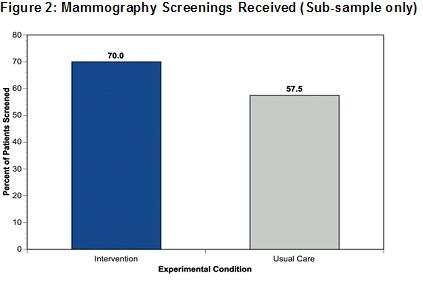The Implementation Guide is a resource for implementing this evidence-based program. It provides important information about the staffing and functions necessary for administering this program in the user's setting. Additionally, the steps needed to carry out the program, relevant program materials, and information for evaluating the program are included. The Implementation Guide can be viewed and downloaded on the Program Materials page.
Program Synopsis
Designed to increase breast cancer screening by encouraging women to schedule and keep mammography appointments, this clinic-based intervention provides a series of reminders to patients to schedule an appointment, including personalized letters or emails, a brochure, and a scripted telephone call. The study showed increased mammography screening rates.
Program Highlights
Program Materials
Preview, download, or order free materials on a CD
Implementation Guide
Download Implementation Guide
Program Scores
The Need
Breast cancer is the most common non-dermatologic cancer in women in the United States, and early detection can reduce mortality dramatically. This research was conducted based on the U.S. Preventive Services Task Force screening guidelines at the time, prior to the release of the current USPSTF recommendations on breast cancer screening. The previous guidelines advised for annual or biannual mammography screening for women aged 40 and older. However, many women do not undergo regular mammography screening. Primary care practices need a proactive system to manage the mammography screening needs of their patients.
The Program
The Proactive System to Improve Breast Cancer Screening is a method that can be used by primary care practices to increase screening rates among their patient base by providing a series of reminders to patients to schedule a mammography. Appointment secretaries identify patients who are due for a mammography in the next 3 months and send each patient a personalized letter or e-mail advising the patient to call and schedule a mammography. Patients also receive a brochure that explains preventive services (i.e., mammography screening; other types of preventive procedures, including vaccinations and Papanicolaou, colorectal, and lipid screenings). Patients who do not respond to the initial mailing receive a second mailing 1 month later. Those who do not respond to the second mailing within 1 month receive a scripted telephone call from the appointment secretary.
Community Preventive Services Task Force Finding
 This program uses an intervention approach recommended by the Community Preventive Services Task Force: client reminder interventions (Breast Cancer Screening).
This program uses an intervention approach recommended by the Community Preventive Services Task Force: client reminder interventions (Breast Cancer Screening).
Time Required
Time required to implement the intervention will vary according to the efficiency of the patient identification procedure used, the number of patients contacted, and the number of contacts necessary to schedule the mammography screening.
Intended Audience
The intervention is intended for women aged 40 to 75 and the primary care practices that serve them.
Suitable Settings
The intervention is designed for use by primary care practices.
Required Resources
The programmatic materials include: a reminder letter, "The Road to Better Health" brochure, intervention flowchart, and a telephone script used to follow up with those who did not respond after the second reminder letter.
About the Study
Women between the ages of 40 and 75 who were patients of a large primary care practice were randomly assigned to either an intervention group or a usual-care control group. Of the 6,665 women identified to have consented to participate in this specific study or had documented authorization allowing access to their medical records for general research, 3,326 were assigned to the treatment group, and 3,339 were assigned to the usual-care control group; 232 women assigned to the treatment group and 286 women assigned to the control group declined participation. The sample included a subsample of employees of the primary care practice. Women in the treatment group received personalized letters or e-mails to remind them to schedule a mammography appointment, an informational brochure, and a follow-up phone call if they did not respond to reminders within a specified time. Women in the usual-care group did not receive reminders, a brochure, or a phone call.
The outcomes measure was mammography screening rates assessed from participant medical records.
Key Findings
Following the intervention, 64.3% of women in the intervention group received mammography screening, compared to 55.3% of women in the usual-care control group (p<.001).

Overall, mammography screening rates were higher for employees of the primary care practice than for nonemployees; 70% of intervention group employees received an annual mammography screening, compared to 57.5% of usual-care control group employees (p<.001).





